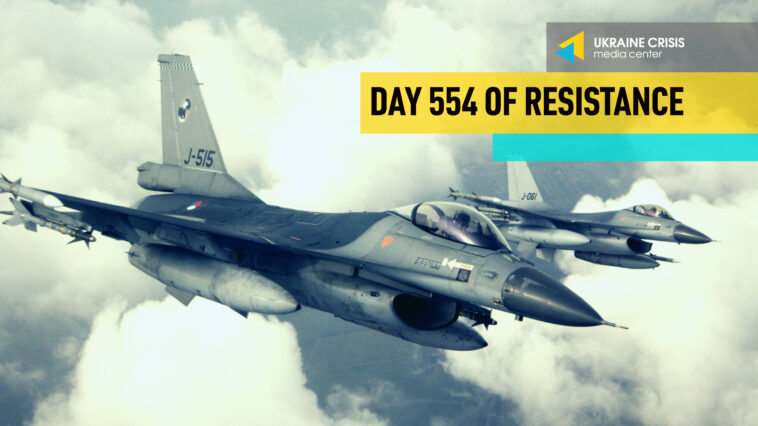The Ukrainian counteroffensive pierces the main Russian defensive line in the southeast, the Wall Street Journal says. Ukraine needs 160 F-16 fighter jets, Zelenskyi says. A Ukrainian-made weapon hit a target at a distance of 700 km, Zelenskyi says.
Ukraine needs 160 F-16 fighter jets, Zelenskyi says
Ukraine has agreements for the supply of about 50 F-16 fighter jets, but needs around 160 F-16s to protect the sky, Ukrainian President Volodymyr Zelenskyi said in an interview with Portugal’s RTP TV channel.
“Today we have agreements for the delivery of 50-60 fighter jets. We need about 160 fighter jets in total to create a powerful fleet that will not allow Russia to dominate the skies,” he said.
It is important that the process has started, even though it happened “a little later” than expected, he said, adding that Ukraine has repeatedly asked its partners to close the sky since the first days of the war.
Zelenskyi said that F-16s are most needed to protect civilians and ensure security of the grain corridor and not to bolster the counteroffensive.
Ukrainian counteroffensive pierces main Russian defensive line in southeast, WSJ says
Ukrainian forces have penetrated the main Russian defensive line in their country’s southeast, The Wall Street Journal said on Thursday, August 31, quoting an unnamed Ukrainian officer.
Ukrainian paratroopers are fighting through entrenched Russian positions on the edge of the village of Verbove, a Ukrainian officer in the area said. Ukrainian forces have also reached the main defensive line to the south of nearby Robotyne village, he said.
Describing the advance, the Ukrainian officer held up three fingers representing lines of attack through entrenched Russian positions on the western flank of Verbove, an agricultural village of some 1,000 residents before the war.
The significance of the advance is that it marks the first time Ukraine has penetrated the main Russian defensive line, an extensive system of minefields, trenches and antitank obstacles covered by artillery.
Ukrainian forces are now working to expand the cracks in the line to create a hole large enough for Western-provided armored vehicles to push through with sufficient logistical support.
According to the General Staff of the Ukrainian Armed Forces, Ukrainian troops continue an offensive operation on the Melitopol axis. They continue to advance southeast of Robotyne toward Novoprokopivka and Ocheretuvate, and have had success near Verbove.
In a report on August 26, the Institute for the Study of War, quoting Reuters said that a Ukrainian commander fighting in southern Ukraine stated that Ukrainian forces believe they have broken through the most difficult line of Russian defenses in the area and will now be able to advance more quickly. A Ukrainian commander told Radio Free Europe/Radio Liberty that Russian forces had built fortified defenses, including concrete-lined trenches. Ukrainian troops have cleared lanes through the minefields so that their equipment and infantry can pass and advance.
Ukrainian-made weapon hits target at a distance of 700 km, Zelenskyi says
Ukraine’s Ministry of Strategic Industries said a Ukrainian-made weapon had hit a target at a distance of 700 kilometers.
President Zelenskyi said he got reports of the successful use of Ukraine’s long-range weapons during a conference call with the cabinet and military commanders. He gave no other details. “I heard a report of the commander-in-chief of the battlefield situation, defensive and offensive actions. Our advance does not stop.”
“The Defense Ministry reported about the weapons and ammunition it received, particularly, about a large batch of armored Medevac vehicles. That’s what we now need,” he said.
“The Ministry of Strategic Industries reported about its own production and successful use of our long-range weapons: a target was hit 700 kilometers away!” Zelenskyi added.
Social media and freedom of speech in the times of war. Ukraine in Flames #501
Social networks have evolved to be more than just communication platforms, they have become crucial tools for information dissemination. However, despite the central role of freedom of speech in this process, we frequently encounter the “chilling effect” phenomenon and self-censorship, where individuals refrain from expressing themselves openly to avoid the risk of being blocked. Watch Ukraine in flames #501 to find out about trends, risks and constructive ideas to overcome the problems of content moderation.
Guests:
- Ihor Rozkladai, Chief Media Lawyer, Deputy Director of the Centre for Democracy and Rule of Law
- Pavlo Burdiak, Analyst of the “Independent Media” Department of the Centre for Democracy and Rule of Law
- Serhiy Syrbu, Analyst of the “Independent Media” Department of the Centre for Democracy and Rule of Law




